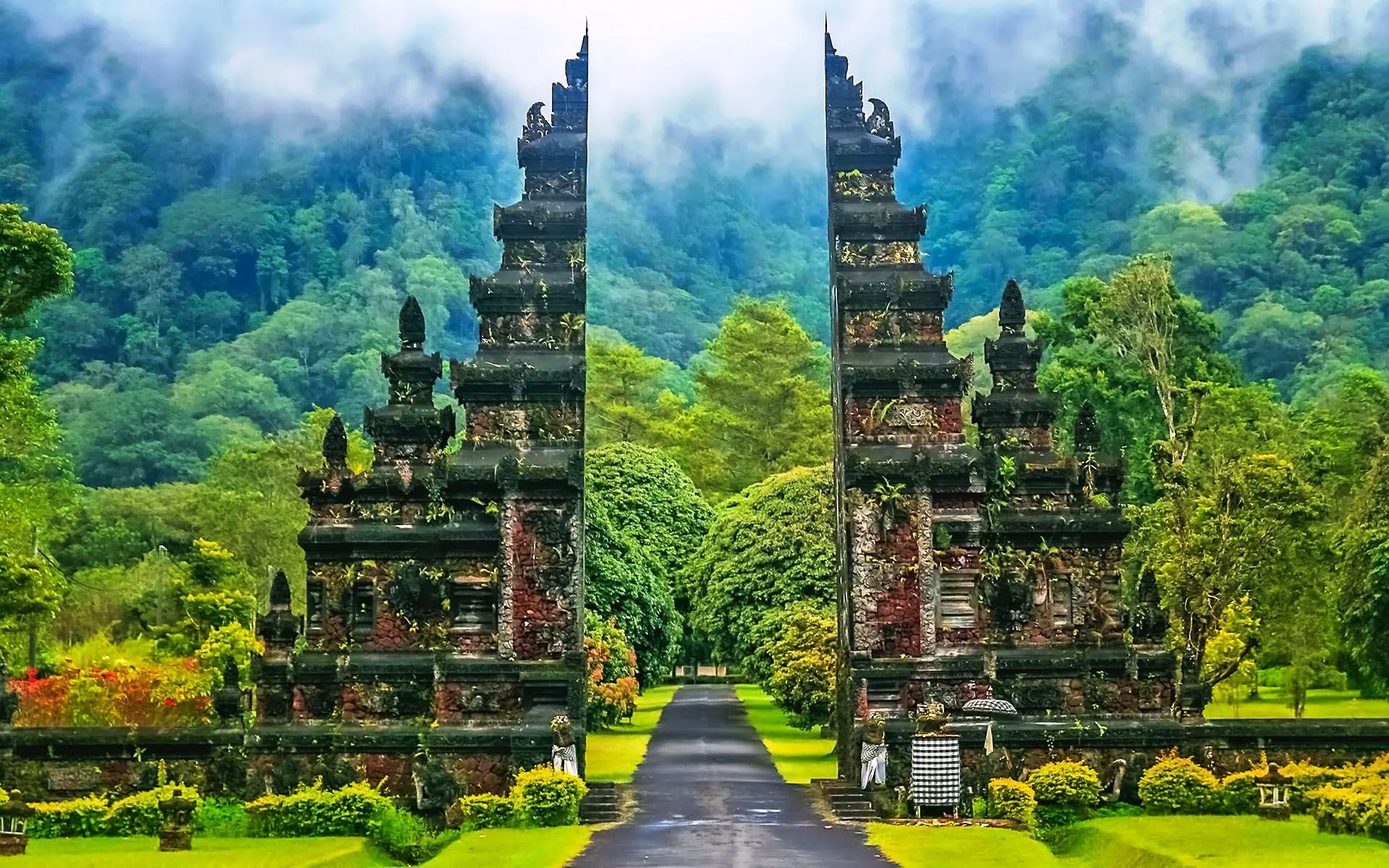
Indonesia A Journey to the Ancient Hindu-Buddhist Culture
Traveling to Indonesia can be an unforgettable experience, as the country offers a unique blend of natural beauty, cultural diversity, and adventurous activities. Below are some of the top reasons why you should visit Indonesia:
Natural Beauty and Diversity
Bali: A world-famous island known for its beautiful beaches, lush greenery, and yoga retreats.
Raja Ampat: One of the world’s most beautiful and rich marine life archipelagos.
Java: Rich in volcanoes, tea plantations, and historic temples.
Sumatra, Kalimantan, and Sulawesi: Diverse wildlife, rainforests, and the opportunity to see orangutans.
Religious and Cultural Heritage
Borobudur Temple: The world’s largest Buddhist temple, a UNESCO World Heritage Site.
Prambanan Temple: A major Hindu temple complex.
Cultural dances and local customs, such as the Balinese Kecak Dance.
Delicious and Varied Food
Indonesian cuisine, such as nasi goreng, satay, rendang, and gudeg, is unique in its flavor and spices.
Each island has its own specialties, such as the signature dishes of Bali, Java, and Sumatra.
Adventure and Adventure Activities
Scuba diving and snorkeling: World-class experiences in Komodo, Raja Ampat, and Bali.
Hiking and Trekking: Climb active volcanoes like Mount Bromo and Mount Rinjani.
Surfing, river rafting, yoga retreats, and more.
Unique Fauna
Komodo Dragons: Found only in Indonesia, specifically on Komodo Island.
Sumatra and Borneo are ideal for spotting orangutans, leopards, and rare birds.
Affordable Travel
The cost of accommodation, food, excursions, and activities is relatively low, especially compared to Western or European countries.
Friendly People and Hospitality
Indonesians are extremely polite and welcoming. In local culture, guests are considered “gods.”
If you want to visit Indonesia’s ancient sculptures and temples, it will take you to the golden age of Hindu-Buddhist culture. Below, I’ve provided a travel guide-style description:
Indonesia’s Ancient Hindu-Buddhist Culture: A Journey
1. Borobudur Stupa (Borobudur, 9th century, Java)
The world’s largest Buddhist stupa.
Decorated with 2,672 panels and 504 Buddha statues.
A symbol of Mahayana Buddhism.
A UNESCO World Heritage Site.
2. Prambanan Temple (Prambanan, 9th century, Java)
Three main shrines: Shiva, Vishnu, and Brahma.
Storylines from the Ramayana are carved into stone.
A masterpiece of Hindu architecture.
3. Mendut Temple (Mendut, Java)
Buddhist temple located near Borobudur.
There is a huge Buddha statue here, which is about 3 meters high.
Famous for meditation and worship.
4. Penataran Temple (Penataran, East Java)
The largest temple of the Majapahit Empire.
A center of worship for Lord Shiva and Vishnu.
Many statues and inscriptions are preserved here.
5. Tanah Lot Temple (Tanah Lot, Bali)
A Hindu temple built on rocks in the middle of the sea.
Dedicated to Lord Barun (the sea god).
A magnificent view at sunset.
6. Besakih Temple (Besakih, Bali)
Famous as the “Mother Temple of Bali.”
This huge temple complex is the most sacred site in Bali.
Shiva, Vishnu, and Brahma are worshipped here.
7. Candi Jolotung (Candi Jago, East Java)
A mixed Buddhist-Hindu temple from the Majapahit period.
A beautiful blend of Ramayana and Buddhist stories in sculpture.
8. Candi Singosari (Java)
This temple was built in memory of King Kertanegara.
It houses statues of Shiva, Agni, and Buddhist deities.
9. Gunung Kawi (Bali)
Royal rock-cut mausoleum temples.
Memorial of an 11th-century king and queen.
A wonderful blend of Hindu and Buddhist art.
10. Pura Ulun Danu (Bratan, Bali)
Located in the middle of a lake, this temple is dedicated to Goddess Danu (the water goddess).
A center of worship related to water and agriculture.
Travel Experience
You will find glimpses of the worship of Shiva, Vishnu, Buddha, and the goddess in every temple and statue.
The art of the sculptures, the grandeur of the temples, and the Sanskrit inscriptions still reveal the deep cultural connection between India and Indonesia during that period.
Bali still keeps the Hindu tradition alive today.
This trip is not only religious and historical but also a spiritual experience.
Ancient Hindu-Buddhist Cultural Period in Indonesia
Indonesia’s history is not limited to maritime trade and empires, but it has also been deeply influenced by Hindu and Buddhist culture. This influence came from India and remained a part of Indonesia’s identity for centuries.
Ancient Hindu-Buddhist Cultural Period in Indonesia
1. Early Period (1st–4th centuries AD)
Traders and monks from India reached Indonesia by sea.
They propagated Hinduism and Buddhism.
The islands of Sumatra and Java first experienced the influence of the Sanskrit language, Vedas, Puranas, and Mahayana Buddhism.
2. Srivijaya Empire (7th–13th centuries)
Center: Sumatra (Palembang)
This was a powerful Buddhist empire.
Srivijaya spread Buddhism throughout Asia and also maintained close ties with Nalanda University.
During this period, a large number of Buddhist statues and stupas were built in Indonesia.
3. Sanjaya Dynasty and Sailendra Dynasty (8th–9th centuries, Java)
Sailendra Dynasty → Patronage of Buddhism.
The Borobudur Stupa (Borobudur, Java) was built, which remains the largest Buddhist stupa in the world.
Sanjaya Dynasty → Patronage of Hinduism.
The Prambanan Temple (dedicated to Vishnu, Shiva, and Brahma) was built.
4. Majapahit Empire (13th–16th centuries)
Center: East Java (Trowulan)
This is considered the golden age of Indonesia.
Hinduism and Buddhism coexisted here.
Statues of Vishnu, Shiva, and goddesses, as well as Buddhist sculptures, were produced in large numbers.
The influence of Hindu-Buddhist culture spread to Java, Bali, and Sumatra.
5. From Hindu-Buddhist to Islam (after the 15th century)
Islam began to spread with the arrival of Arab and Gujarati traders.
Gradually, Indonesia moved towards Islamic culture.
However, the island of Bali remains a center of Hindu culture, where the worship of Vishnu, Shiva, and the Goddess is intertwined with the Vedic tradition.
Key Features of the Culture
Language: Strong Sanskrit influence (even today, the Indonesian dictionary contains hundreds of Sanskrit words).
Art: Temple architecture (Borobudur, Prambanan), sculpture, and bronze statues.
Literature: Translations and local versions of the Ramayana and Mahabharata (kakawin).
Religious Life: Worship of Shiva, Vishnu, Brahma, Buddha, and the Goddess.
In Summary:
Indonesia’s ancient period (1st–16th centuries) was the golden age of Hindu-Buddhist culture.
To this day, temples, statues, and festivals in Bali, Java, and Sumatra reflect this culture.
Tour of Ancient Vishnu Statues in Indonesia
Indonesia, especially Java and Bali, was an important center of Hindu-Buddhist culture in ancient times. Magnificent and historic statues of Lord Vishnu can still be seen in many places here.
Tour of Ancient Vishnu Statues in Indonesia
1. Garuda Wisnu Kencana, Bali
Location: GWK Cultural Park, Bali
Features: This is the grandest statue of modern times, but it is based on ancient traditions.
With a height of approximately 121 meters, it is considered the tallest Vishnu statue in the world.
Here, Vishnu is seen riding on Garuda, a symbol of righteousness and power.
2. Airlangga as Vishnu, Trowulan, East Java
Location: Trowulan Museum, East Java
Features: This statue depicts King Airlangga (11th century) as Vishnu.
It depicts Vishnu seated on Garuda.
It is an excellent example of Hindu architecture from the Majapahit Empire.
3. Prambanan Temple Complex, Java
Location: Yogyakarta, Java
Speciality: UNESCO World Heritage Site.
It is primarily dedicated to Shiva, but its temple complex also includes beautiful temples dedicated to Vishnu and Brahma.
An ancient stone statue of Lord Vishnu is still installed in the Vishnu Temple.
4. National Museum of Indonesia
Location: Jakarta, the capital
Speciality: It houses numerous Hindu sculptures brought from ancient Java, Bali, and Sumatra.
Rare bronze and stone statues of Lord Vishnu can be seen here.
5. Candi Sukuh & Candi Cetho, Solo (Central Java)
Speciality: These temples date back to the late 15th century.
The statues of Vishnu and other Hindu deities here are created in a distinctive Javanese style.
Travel Experience
When touring these statues in Indonesia, you will discover that:
Each statue reflects a fusion of Hindu philosophy and local Javanese art.
The expressions on the statues’ faces convey a sense of peace, divinity, and meditation.
Local people still worship Vishnu and other deities, offering a vibrant cultural experience.
Art Characteristics and Style
These sculptures share some common features:
Bronze Material
Most Vishnu sculptures are made of bronze because it is durable and better protected from weathering.
Positioned/Lotus Positions
Statues are seen in standing postures or in serene seated positions such as Padmasana/Virasana.
Standing sculptures hold various symbols in their hands, such as a conch (shankha), chakra (chakra), mace (gada), lotus (padma), etc.
Lotus Pedestal/Aureole/Halo
The pedestal of the sculptures is often shaped like a lotus petal.
Many sculptures have a luminous background (aureole or halo) behind them, enhancing the divinity of the sculpture.
Ornamentation
Beads, crowns, jewelry, and ornamented clothing all enhance the beauty of the statues.
Facial expressions are often calm, meditative, and spiritual.
Architecture and Modulation
In the Majapahit style, statues were made in multiple parts and then assembled.
Ornate crowns and distinctive mudras are hallmarks of the statues.
Examples and Modern Projects
Garuda Wisnu Kencana (GWK), Bali: This is a modern but significant symbol of Hindu culture and sculpture. It depicts Vishnu riding on Garuda.
The statue stands approximately 121 meters tall.
The project began in 1990 and was completed in 2018.
Note:- What is your opinion about Indonesia A Journey to the Ancient Hindu-Buddhist Culture? Please tell us in the comment box below. Your opinion is very important to us.


One thought on “Indonesia A Journey to the Ancient Hindu-Buddhist Culture”